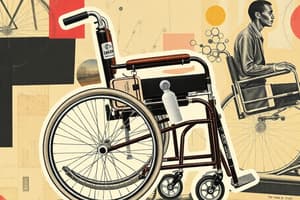Podcast
Questions and Answers
What are normal ranges for blood components known as?
What are normal ranges for blood components known as?
- Health benchmarks
- Reference laboratory values (correct)
- Diagnostic thresholds
- Clinical standards
Which of the following precautions should be taken when exercising with low blood counts?
Which of the following precautions should be taken when exercising with low blood counts?
- Extend workout duration significantly
- Engage in high-impact sports
- Monitor for dizziness and fatigue (correct)
- Increase exercise intensity gradually
What is a critical consideration regarding anticoagulation therapy?
What is a critical consideration regarding anticoagulation therapy?
- It enhances muscle strength
- It increases the risk of bruising and bleeding (correct)
- It promotes faster recovery from injuries
- It allows for unrestricted exercise activities
What function do catheters serve in medical care?
What function do catheters serve in medical care?
What are ostomy devices primarily used for?
What are ostomy devices primarily used for?
What is confirmation of fit when discussing wheelchairs?
What is confirmation of fit when discussing wheelchairs?
What is the procedure used to adjust and confirm a wheelchair's fit?
What is the procedure used to adjust and confirm a wheelchair's fit?
What are the potential consequences of improper wheelchair fit?
What are the potential consequences of improper wheelchair fit?
Which of the following is NOT a level of assistance in transfers?
Which of the following is NOT a level of assistance in transfers?
Which step is important for patient safety during transfers?
Which step is important for patient safety during transfers?
What conditions require special precautions during transfers?
What conditions require special precautions during transfers?
What is a common type of assistive device?
What is a common type of assistive device?
How should an assistive device be fitted to a patient?
How should an assistive device be fitted to a patient?
Flashcards
Reference lab values
Reference lab values
Normal ranges for blood components, like hemoglobin or platelets.
Precautions with low blood counts
Precautions with low blood counts
Monitor for dizziness, fatigue, and avoid overexertion.
Anticoagulation risks
Anticoagulation risks
Increased chance of bruising and bleeding; avoid high-impact exercises.
Catheter use
Catheter use
Signup and view all the flashcards
Ostomy device
Ostomy device
Signup and view all the flashcards
Wheelchair Fit Confirmation
Wheelchair Fit Confirmation
Signup and view all the flashcards
Wheelchair Components
Wheelchair Components
Signup and view all the flashcards
Transfer Assistance Levels
Transfer Assistance Levels
Signup and view all the flashcards
Transfer Safety Concerns
Transfer Safety Concerns
Signup and view all the flashcards
Gait Cycle
Gait Cycle
Signup and view all the flashcards
Assistive Device Fit
Assistive Device Fit
Signup and view all the flashcards
Weight-Bearing Statuses
Weight-Bearing Statuses
Signup and view all the flashcards
Assistive Device Selection
Assistive Device Selection
Signup and view all the flashcards
Study Notes
Wheelchair Considerations
- Wheelchair components include seat width, depth, and height; armrests; footrests; backrests; and wheels (drive, casters, and hand rims).
- Proper wheelchair fitting ensures the chair matches the patient's size and needs, preventing discomfort, injuries, and poor mobility.
- Procedure 7.1 involves adjusting and confirming wheelchair fit, considering seat dimensions, armrests, and footrest placement.
- Improper wheelchair fit can lead to skin breakdown, poor posture, circulatory issues, and difficulty with propulsion or maneuvering.
Transfer Activities
- Transfer assistance levels range from independent to dependent, including standby, minimal, moderate, and maximal assistance.
- Transfer procedures involve positioning the wheelchair, locking brakes, using gait belts, and maintaining proper body mechanics.
- Transfer safety concerns include preventing falls, ensuring patient stability, and removing hazards from the area.
- Special precautions are needed for transfers involving orthopedic conditions (e.g., hip replacements), neurological conditions (e.g., stroke), and cardiac concerns.
Assistive Devices
- Gait cycle describes the sequence of motions during walking, from heel strike to heel strike.
- Stance phase sub-phases are: heel strike, foot flat, mid-stance, heel off, and toe-off.
- Swing phase sub-phases are: initial swing, mid-swing, and terminal swing.
- Muscles active during the gait cycle include quadriceps, hamstrings, and calf muscles.
- Ambulation preparation involves assessing strength, balance, and weight-bearing status, and ensuring proper footwear and a safe environment.
- Common assistive devices include walkers, canes, crutches, and parallel bars.
- Assistive device selection depends on mobility needs, coordination, and weight-bearing ability.
- Assistive device fit involves adjusting the device so its handle is at the patient's wrist crease when standing.
- Weight-bearing statuses include Non-Weight Bearing (NWB), Partial Weight Bearing (PWB), and Full Weight Bearing (FWB).
- Basic gait patterns with assistive devices include 2-point, 3-point, 4-point, swing-to, and swing-through.
Special Equipment
- Reference laboratory values represent normal ranges for blood components like hemoglobin and platelet counts.
- Precautions for low blood counts during exercise include monitoring for dizziness, fatigue, and avoiding overexertion.
- Anticoagulation therapy increases the risk of bruising and bleeding, so high-impact exercises should be avoided.
- Catheters are tubes for draining urine, requiring careful handling to prevent infections.
- Oxygen therapy systems, like nasal cannulas or masks, aid breathing.
- Chest drainage systems remove air, blood, or fluid from the pleural cavity.
- Ostomy devices are appliances attached to stomas for waste collection, needing secure placement and hygiene.
Studying That Suits You
Use AI to generate personalized quizzes and flashcards to suit your learning preferences.
Description
This quiz covers essential considerations for wheelchair fitting and transfer activities. It addresses the importance of proper wheelchair adjustments to enhance mobility and prevent injuries. Additionally, it explores safe transfer procedures and assistance levels critical for patient care.




